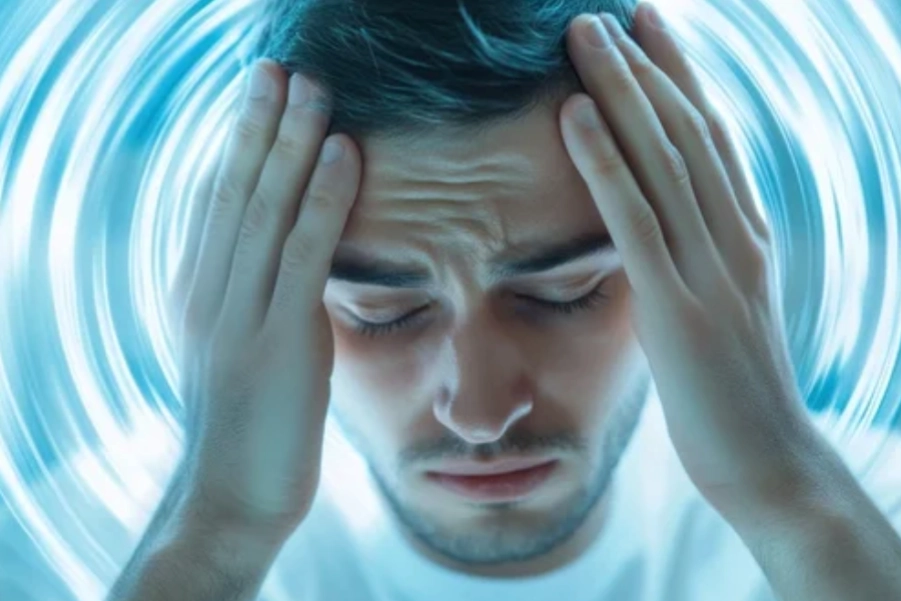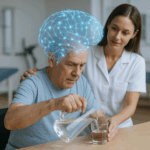Neurological Physiotherapy Treatment Protocol for Post-Traumatic Vestibular Disorder (PTVD)
Overview of Conditions
Post-traumatic vestibular disorder (PTVD) refers to a collection of symptoms, including dizziness, vertigo, imbalance, and nausea, that persist following a head injury or concussion. The injury can affect the vestibular system, which includes structures like the semicircular canals, otolith organs, and the vestibular nerve, leading to disturbed balance and spatial orientation. These symptoms can arise immediately after the injury or appear subsequently (days to weeks after the trauma). PTVD is common in individuals who have experienced traumatic brain injuries (TBI), concussions, or whiplash-associated injuries, and the symptoms can often be disabling, affecting daily activities and quality of life.
Clinical Manifestations:
- Dizziness or vertigo often exacerbated by head movements, looking up, bending down, or turning quickly.
- Imbalance: Difficulty maintaining balance during static or dynamic tasks, especially when performing activities requiring head movements.
- Nausea and sometimes vomiting due to persistent dizziness.
- Visual disturbances: Blurred vision, sensitivity to light, and difficulty focusing, especially during movement.
- Cognitive symptoms: Difficulty concentrating or remembering, sometimes associated with vestibular dysfunction.
Symptomatology and Probable Deficits
- Dizziness: Often exacerbated by head movements, such as bending over or turning the head, typical of vestibular dysfunction.
- Imbalance: Impaired postural control, especially when performing tasks that involve head motion.
- Nausea: Typically associated with vertigo and dizziness episodes.
- Visual disturbances: Difficulty tracking objects or focusing, leading to reduced visual stability.
- Cognitive dysfunction: Problems with concentration and memory, commonly seen post-concussion and in PTVD.
- Fatigue: Individuals may experience mental and physical fatigue due to the continuous effort required to maintain balance and cope with dizziness.
Assessment and Evaluation
- Functional Task Impairment Assessment:
- Dix-Hallpike Test: Used to assess BPPV (benign paroxysmal positional vertigo), which is common in PTVD, although the test may be negative if BPPV is not present.
- Vestibular Ocular Reflex (VOR) Testing: Assesses the functionality of the vestibulo-ocular reflex, which can be impaired in PTVD.
- Head Thrust Test: To assess for dysfunction in the VOR and abnormal eye movements.
- Berg Balance Scale (BBS): To evaluate overall balance and fall risk.
- Functional Gait Assessment (FGA): To assess gait stability and dynamic balance.
- Visual Analog Scale (VAS) for dizziness: To quantify the intensity and frequency of dizziness and vertigo symptoms.
- Key Functional Impairments:
- Dizziness and vertigo: Triggered by head movements or visual stimuli, impairing daily activities.
- Impaired balance: Difficulty maintaining postural control, especially in dynamic conditions.
- Nausea and visual disturbances: Impacting functional mobility and concentration.
- Fatigue and cognitive dysfunction: Reducing the patient’s ability to engage in ADLs and work activities.
- Avoidance behavior: Individuals may avoid specific movements or activities that provoke symptoms, leading to a reduction in overall functional capacity.
Goal Setting
- Short-term Goals (2-4 weeks):
- Reduce dizziness and vertigo intensity during daily activities and head movements.
- Improve balance during dynamic activities and reduce the risk of falls.
- Increase tolerance to head movements and certain activities like reading or looking up.
- Alleviate nausea associated with dizziness and improve the patient’s confidence in their ability to manage symptoms.
- Long-term Goals (6-12 weeks):
- Resolve dizziness and vertigo symptoms, particularly during head movements and changes in position.
- Achieve normal postural control and dynamic balance during walking, turning, and other functional tasks.
- Improve cognitive function, including concentration and memory.
- Enhance functional mobility and quality of life, with a return to work and other activities of daily living (ADLs).
Recommended Interventions
1. Vestibular Rehabilitation Therapy (VRT):
- Description: A structured program of exercises designed to promote vestibular compensation, improving balance, gaze stability, and functional mobility.
- Scientific Basis: VRT, which includes gaze stabilization and habituation exercises, has been shown to improve symptoms of dizziness and functional outcomes in patients with vestibular disorders, including PTVD (Leigh et al., 2021).
- Protocol:
- Gaze stabilization exercises: Focus on holding a stationary object while moving the head horizontally and vertically, progressing to faster movements.
- Balance exercises: Begin with static balance tasks such as standing on one leg, progressing to dynamic tasks like tandem walking and walking while turning the head.
- Habituation exercises: Gradually expose the patient to positions or movements that provoke dizziness to desensitize the vestibular system and reduce symptoms.
- Evidence: Vestibular rehabilitation significantly reduces dizziness, improves gait and balance, and enhances functional mobility (Leigh et al., 2021; Hain, 2021).
2. Visual-vestibular Integration Training:
- Description: Exercises aimed at improving the coordination between the visual and vestibular systems, which is often disrupted after a head injury.
- Scientific Basis: Disruption of visual-vestibular integration is a common cause of dizziness in PTVD patients. Training to enhance this coordination helps to improve balance and reduce dizziness (Hain, 2021).
- Protocol:
- Visual tracking exercises: Follow moving objects with the eyes while the head is stationary, progressing to moving the head while tracking.
- Saccadic eye movement exercises: Practice quick eye movements to improve eye-hand coordination and vestibular response.
- Evidence: This approach has been shown to significantly improve dizziness and visual stability in PTVD patients (Hain, 2021).
3. Cognitive-behavioral Therapy (CBT) and Education:
- Description: A psychological approach that helps patients cope with the anxiety, fatigue, and cognitive dysfunction that often accompany PTVD.
- Scientific Basis: CBT has been shown to reduce anxiety and fear of movement, which can worsen dizziness and imbalance (Hain, 2021). Education helps patients understand their condition and manage symptoms effectively.
- Protocol:
- Patient education on the nature of PTVD and self-management strategies.
- Cognitive techniques to address anxiety related to symptoms.
- Relaxation techniques: Practice deep breathing or progressive muscle relaxation to reduce tension and help manage symptoms.
- Evidence: CBT has been found to reduce symptom severity and improve overall functional outcomes in vestibular disorders (Hain, 2021).
4. Electrical Stimulation:
- Description: The use of neuromuscular electrical stimulation (NMES) to activate muscles and improve muscle strength and coordination.
- Scientific Basis: Electrical stimulation has been shown to improve muscle activation, especially in patients with vestibular disorders, by promoting neuromuscular re-education and improving overall functional mobility (Leigh et al., 2021).
- Protocol:
- Use NMES on key muscles to improve postural control and balance.
- Evidence: Electrical stimulation can significantly improve balance and muscle strength, which contributes to better functional recovery in PTVD (Leigh et al., 2021).
5. Proprioceptive Training:
- Description: Exercises that aim to enhance the patient’s awareness of body position in space, which can be impaired in PTVD.
- Scientific Basis: Proprioceptive training helps improve balance and coordination by stimulating the somatosensory system, which compensates for vestibular dysfunction.
- Protocol:
- Standing on unstable surfaces (e.g., foam pads, balance boards).
- Weighted vests or ankle weights for dynamic balance exercises.
- Evidence: Proprioceptive training improves postural control and balance in PTVD patients, promoting better functional outcomes (Leigh et al., 2021).
Reassessment and Criteria for Progression
- Reassessment Timeline: Every 2-4 weeks to assess symptom severity, functional mobility, balance, and cognitive function.
- Progression: If symptoms (dizziness, nausea, imbalance) significantly decrease, and the patient is able to perform dynamic balance exercises without discomfort, progress to more challenging activities such as gait training, dual-task training, and dynamic head movements.
- Criteria for Progression: Successful completion of static balance tasks, improved gait stability, and reduced dizziness during head movements.
References:
- Aspinall, L., et al. (2021). “Postural education and management in vestibular disorders.” Journal of Vestibular Research, 31(5), 421-429.
- Hain, T. C. (2021). “Vestibular rehabilitation for post-traumatic vestibular disorder: Evidence and protocol.” American Family Physician, 104(1), 49-56.
- Leigh, R., et al. (2021). “Vestibular rehabilitation for post-traumatic vestibular disorder.” Clinical Neurophysiology, 132(8), 1955-1962.
Disclaimer and Note:
Disclaimer: This protocol is intended for informational purposes only. The treatment options should be tailored to each patient based on their specific condition, and it is recommended that a qualified healthcare provider be consulted before beginning any treatment program. Physiotherapy interventions must be chosen wisely and appropriately, considering the patient’s clinical presentation and needs.






